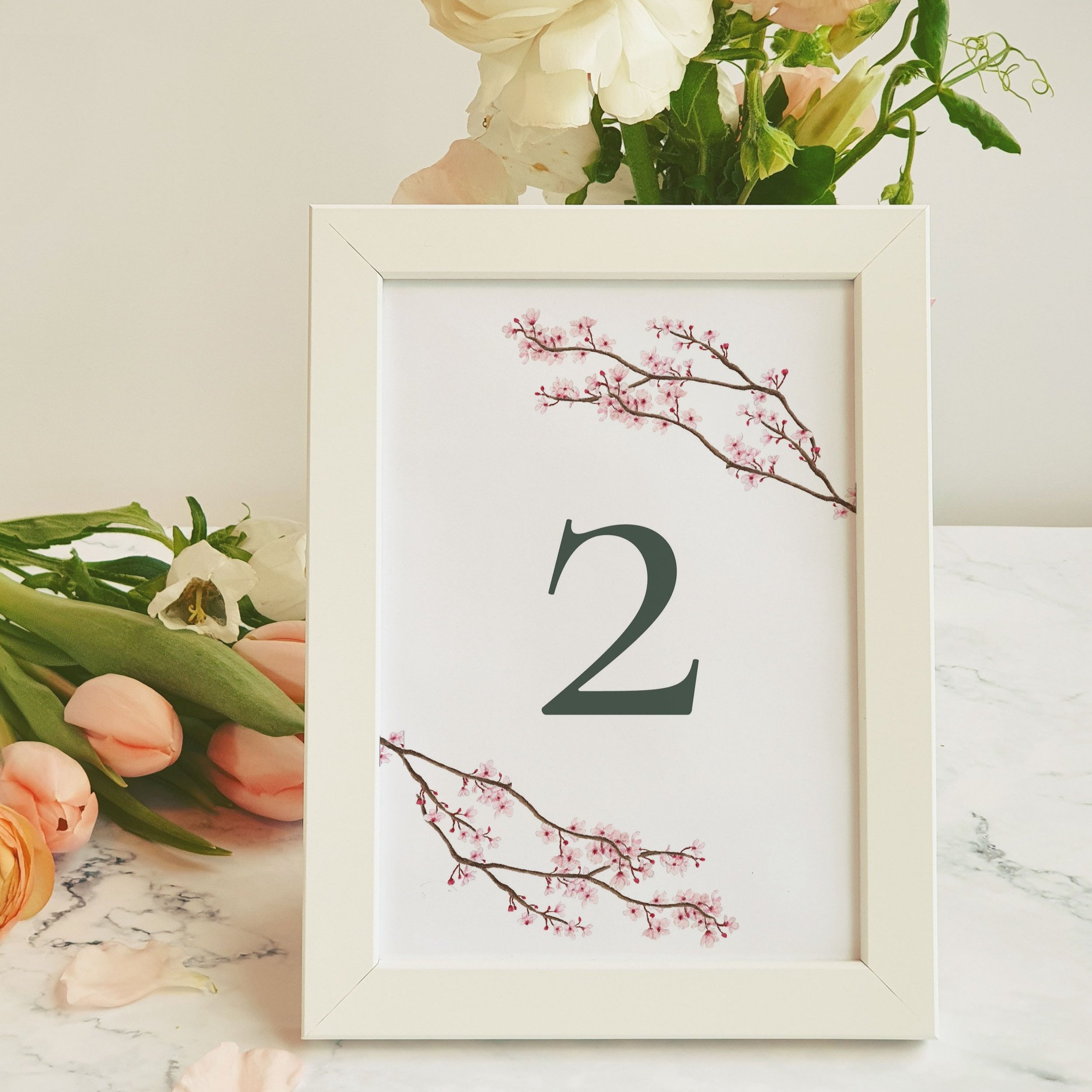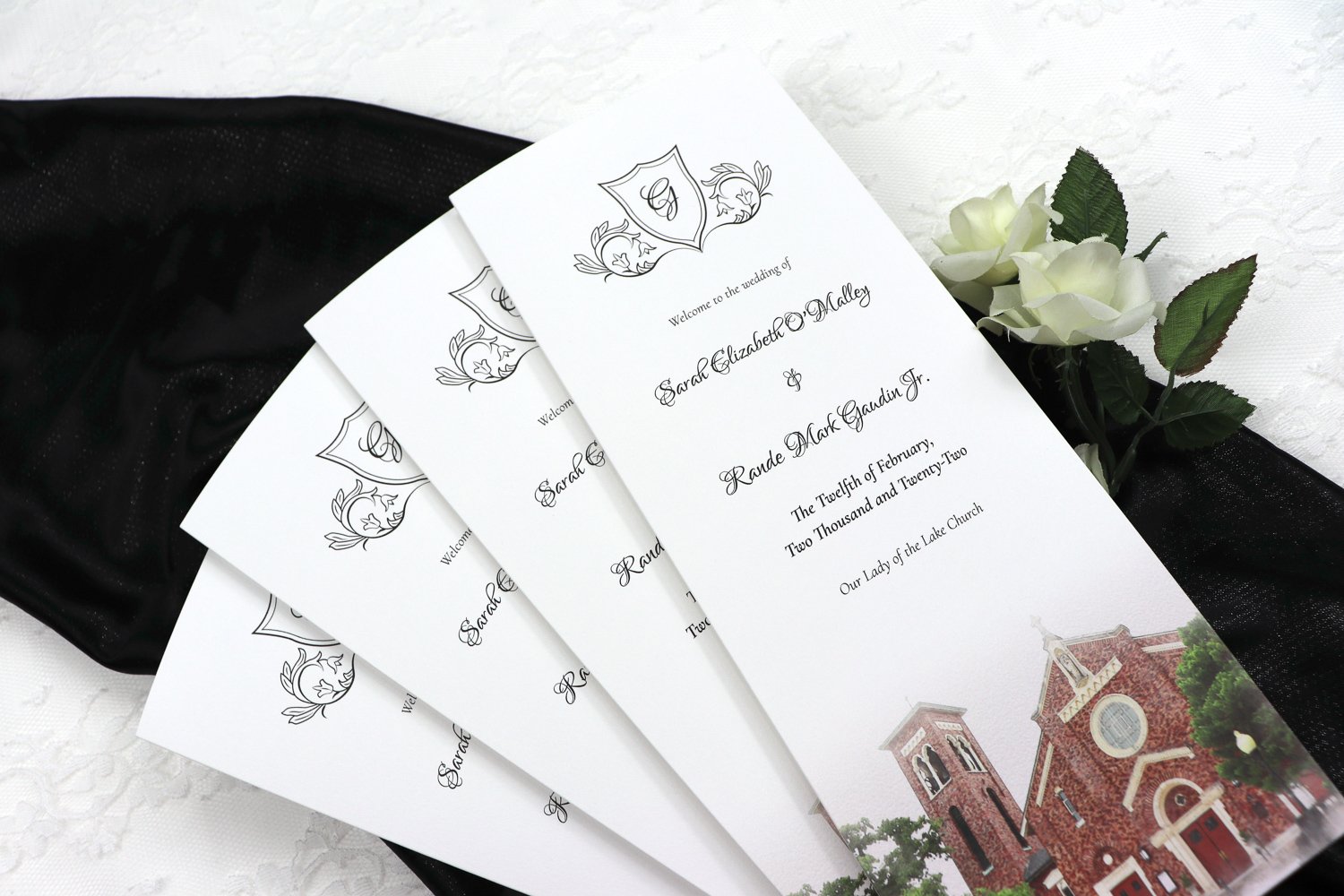Wedding Day Stationery: What Wedding Paper Goods Do You Need on the Big Day?
Chances are you know that you need both save the dates and invitations for your wedding (and if you’re not sure of the difference, check out this blog). We love helping couples design unique and deeply personal wedding invitations for their big day!
And if you invest in a custom design, it’s even more special to carry that personalization through to your wedding day-of stationery. You know, the wedding menus, escort cards, table numbers, programs, signage, etc. But what on-the-day wedding stationery do you actually need?
The answer depends on the style and format of your wedding, which means the answer will be different for everyone. In this blog, we’ll discuss the different types of wedding day-of stationery, why they’re needed, what info you should include on each, and help you decide which pieces are right for you.
Wedding Menus
Wedding menus are important only if you’re having a sit-down dinner. (So if you’re having a cocktail-style reception, skip down to wedding programs!) If you're giving more than one entrée option, then your guests should have chosen their meal when they returned their RSVP. But menus are a great way to share first courses, second courses, and side items. They also remind your guests of their entrée choice and get their mouths watering before the waiters make an appearance!
What to include: First course, second course, entrée(s) with side items, and dessert. Feel free to add a short description of each course. For example, for a salad course, you may mention the type of salad and/or the salad dressing.
Wedding Escort Cards/Place Cards
Photo Credit Erika Parker Photography
Escort cards v. place cards–what’s the difference?
Place cards are set up on the dining table at each guest’s specific seat and only display the guest’s name. They are sometimes combined with a seating chart for larger events, which will indicate each guest’s table number.
Escort cards display both the guest’s name and his or her designated table number. They are set up at the entrance of the dining area for your guests to find their names and carry their cards to their assigned table. They can then choose which seat they prefer at that table.
In short, a place card requires your guests to sit in a specific seat. Escort cards assign a specific table, but guests can choose their chair at that table.
Now, which is better for you? If you’re having a small event with just one or two long tables, then place cards are a good way to go. This will take out any confusion about who’s sitting where at the banquet tables. (Nor will anyone feel the need to save seats!) If your event is large with lots of long, winding tables, then combining place cards with a seating chart may help traffic flow more smoothly.
Escort cards are best for a mid-sized event with round tables that seat 6-10 people. Guests will be able to easily find their card at the entrance and then choose their seat at the proper table. Just make sure those cards are alphabetized when you drop them off at your venue. (At Camellia Memories, we always make sure that step is done for you!)
What to include: One guest name per card. For escort cards, also include the guest’s table number. Finally, if you're having multiple meal choices, you may color code or otherwise mark each place card/escort according to the guest's meal choice. This helps the wait staff easily deliver the right dinners to your guests.
Wedding Table Number Cards
Table numbers are rather straightforward. In most cases, you’ll only need a few that display the table number large enough to be seen at a distance. A 5 x 7 card is usually big enough, although you may be able to get away with slightly smaller cards if your venue is well-lit. If you’re having rows of long tables, you may need two or three copies of each number to set along the table length.
The biggest question to ask yourself about table numbers is how you’ll display them. Will you use a frame that you purchase or rent? Or will you incorporate them into the centerpieces with a cardholder? If using as part of the centerpiece, you may consider printing the cards double-sided so that guests can see the number from whichever side they approach.
What to include: The table number.
Wedding Programs
One of the most flexible pieces of wedding day stationery, wedding programs can (and should be) highly personalized. When thinking about your program, consider any information that may be useful or entertaining to your guests while they wait for the ceremony to start.
Common sections to include in a program:
Wedding Announcement on the front (names, date, location, etc.)
Bridal Party
Ceremony Outline (especially if your ceremony includes religious or cultural practices)
Reception Itinerary (especially if you’re having a unique reception format or activities)
Thank you note to guests
Memorial to commemorate loved ones who have passed
New home address if you’re moving after the wedding
Wedding hashtag
Fun facts or a short story about the two of you
Never feel obligated to include all or any of the above-mentioned sections in your program. In fact, if you’re having a short ceremony with a standard reception format, then you may choose to skip the program altogether. When deciding if a program is right for you, ask yourself if it will enhance your guests’ enjoyment or help them navigate or understand the evening better.
Final tip: If your ceremony will be outdoors on a warm day, you may consider programs so that your guests have a makeshift fan!
Wedding Signs
This section could be a blog by itself. There are endless possibilities for your wedding signage–both from a content and material standpoint. But today we’ll keep it simple and just discuss the most common signs used at weddings:
Welcome Sign – Displayed at the entrance of the ceremony and/or reception.
Guest Book Sign – Attracts your guests’ attention so that they don’t miss out! If your guest book is non-traditional, you can also use this sign to give instructions.
Seating Chart – Can replace the escort cards or be used in combination with place cards.
Bar Sign – Necessary if having a signature cocktail, but it can also list what’s on tap.
Bathroom Sign – Good to have if your venue is large and the bathrooms are hard to find.
Photo Booth Sign
Other Signs – If you’re planning any unique wedding reception details or events, make a sign so your guests know about it!
Like with the program, signs can be added or omitted depending on your needs and budget. In addition, the above signs can be created as large or as small as you like. Go with an 8 x 10 sign (but not for a seating chart) if you’re on a tight budget. Or for a grander effect, choose a large format size on poster paper, foam board, or even a non-paper option like wood, acrylic, or a cloth banner. Have fun with your wedding signs while communicating important info to your guests!
Each wedding day stationery piece has its own job and place on your big day. Some you may need, but others you may be able to skip. It’s all up to you! The important thing is that you stay true to yourself and your wedding style.
And if you can, incorporate the same design elements from your invitations into your wedding day-of stationery for a cohesive look! We love helping clients create original day-of stationery based off of their wedding invitations. If you’d like a cohesive look throughout your wedding stationery, reach out to us! We’re always happy to help!






